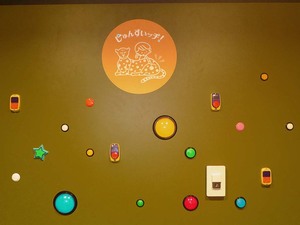Nagoya City Science Museum
TOP > Exhibition Guide > Floor Map> Switch
Switch



Purpose of Exhibition
Children are extremely fond of pushing switches. The switches in exhibits in the Nagoya City Science Museum are no exception. Regrettably, however, many children press the switches and then quickly run away, without looking at the items on display. Given this situation, we have decided to create exhibits that enable children to push switches all they want.
Children love to press switches because the act of pushing a switch often causes interesting changes, such as emitting sound or light. The act of pressing a switch might also cause an exciting feeling on their hand. We hope that children will find much pleasure in pressing many switches and enjoy the resulting changes.
Additional Knowledge
When hearing the word “switch,” you might quickly associate it with something like that used to turn a light off and on. However, the original meaning of “switch” is “making a shift.” Before electricity was in common use in everyday life, the term used to represent changing railway tracks. In baseball, a “switch hitter” means a player who bats both right- and left-handed. The term “switchback” refers to a train changing its direction of travel for a short distance in a zig-zag manner when climbing up and down steep hills.
Electric switches can largely be divided into two categories. One is a switch that is operated by hand for the purpose of doing something. The other is a switch that detects the movements of something. The former includes switches that turn lights on/off and remote control switches for TVs. The latter includes the switch in the refrigerator that turns a light on/off when sensing the door(s) opening or closing. All the switches used in exhibits here fall under the former category.
There are many types in both categories of switches. It might be difficult to see switches used for detecting movement of things firsthand since they are often installed in places that are not visible. However, just think of all the switches you operate in everyday life, and you will understand that there are many different switches. Now, let’s take a look at what types of switches there are.
First, there is the push-button switch. As the name implies, this type of switch operates with a push button. Such push-button switches are used in the exhibits here. Another type of switch is the rocker switch. Its name might sound unfamiliar, but light switches installed on the wall fall into this category. The word “rocker” can mean a rocking chair. Visualize, then, how a rocking chair moves, and you will understand what this type of switch is like. A rocker switch uses a seesaw action. When one side of the switch is pressed down, the other side is raised.
Another type of switch is the toggle switch. You may have never heard of this name, but it is very familiar to those who create electrical circuits. A toggle switch is actuated by moving a small lever, which is often used in the electrical workshops held here at the Science Museum. The rotary switch is a switch that controls the main contact point by rotating the handle. Other types of switches include the slide switch, key lock switch, and tactile switch.
Article by Yoshitaka Yamada, curator
